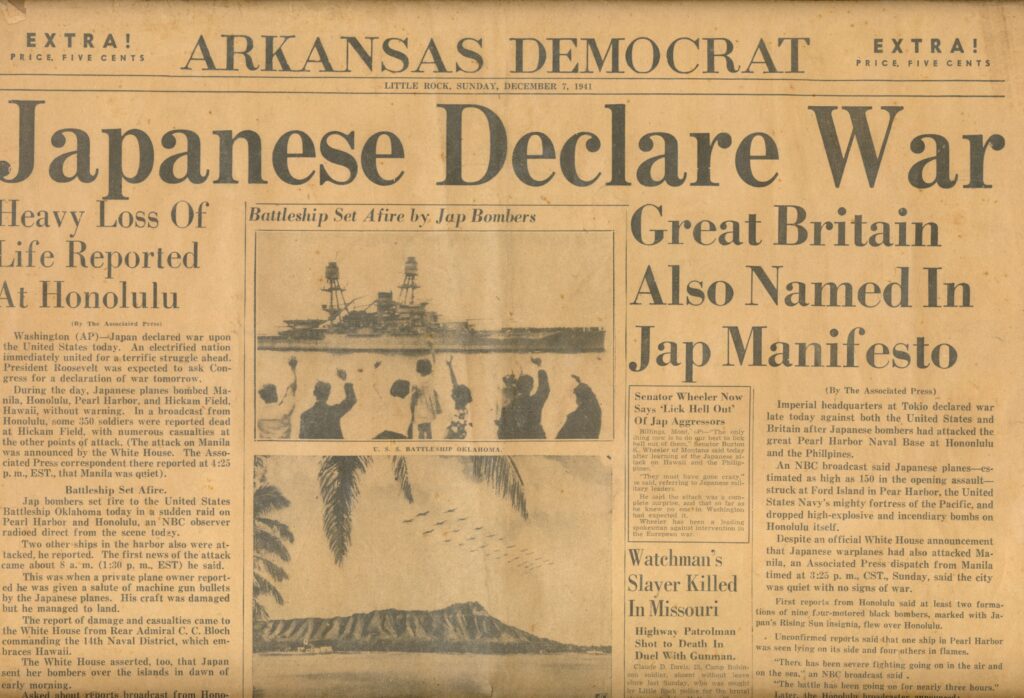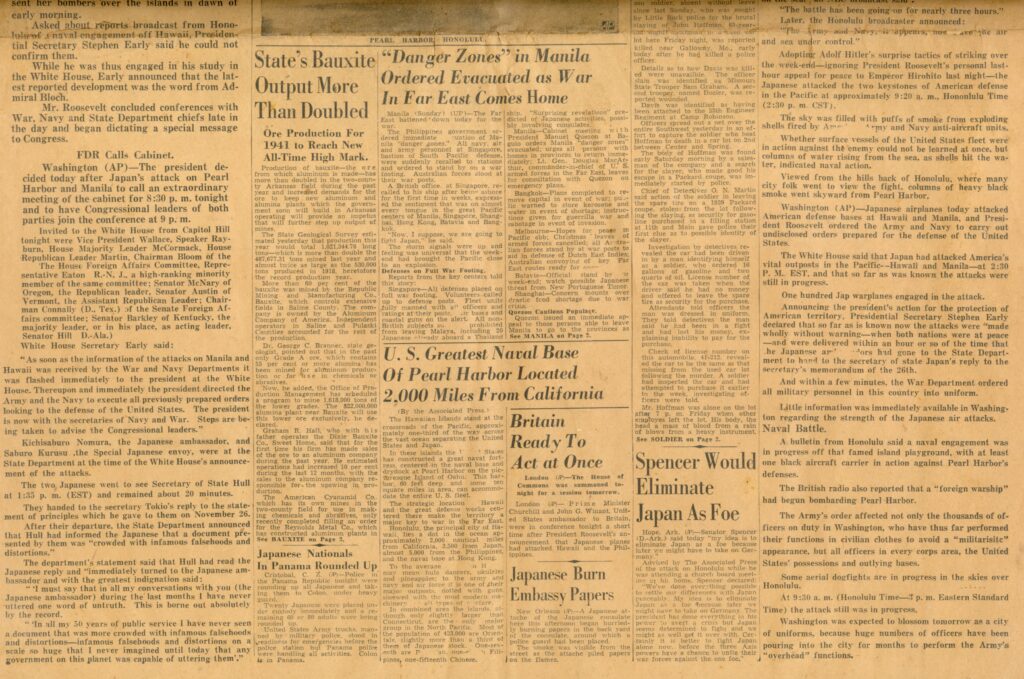Bauxite’s Reaction to Pearl Harbor

By Cody Berry
On December 7, 1941, the Japanese bombed Pearl Harbor in Hawaii, which propelled the United States into WWII. The Arkansas Democrat’s top headline that day read “Japanese Declare War,” above pictures of a battleship on fire and planes flying over the island. That day the Japanese bombed Manila, Honolulu, Pearl Harbor, and Hickam Field, Hawaii “without warning.” A broadcast from the Hawaiian capital said that “some 350 soldiers were reported dead at Hickam Field, with numerous casualties at the other points of attack.”1
Just below the coverage of the attack on Pearl Harbor that day was an article about Bauxite. Arkansas’s Bauxite output more than doubled. The State Geological Survey estimated that production in 1941 would total 1,021,344.76 long tons which was more than double the 487,677.31 long tons that Arkansas had been producing at that time.2 This was almost twice as large as the 530,000 tons produced in 1918, which had previously been the record year. More than 60% of the bauxite was mined by the Republic Mining and Manufacturing Company, which controlled the Saline County mining fields. It was owned by Alcoa.3
Dr. George C. Branner, who was the State Geologist then, pointed out that in the past, only Grade A bauxite ore was mined for aluminum production. Dr. Branner added that the Office of Production Management had scheduled a program to mine 1,618,000 tons of lower grade ore in 1941, and that the $22,000,000 alumina plant near Bauxite, Arkansas, would process lower grade ore exclusively.4
In his book, A Printed and Pictorial History of Bauxite, Gordon Scott Bachus wrote that during WWII new techniques such as the “Alcoa Combination Process” permitted the use of bauxite containing a higher percentage of silica than had ever been used before. This multiplied the state’s bauxite resources and kept it in the aluminum business. Bauxite pits that had been closed after all the high-grade ore was removed, were opened again for the low-grade ore.5
Bachus also stated that the use of both low-grade and high-grade bauxite ore was not only beneficial to the residents of Saline County, but it provided a sense of security as well. At the time, German submarines were patrolling the ocean routes of bauxite shipments to and from South and North America. It was feared that foreign supply may be cut off and Arkansas would have to supply multiple countries.6
Employment figures in the town of Bauxite rose during the war. In 1941, a contract between the United States Defense Plants Corporation and Alcoa led to the creation of the Hurricane Creek Plant. On October 4, 1941, the first trees were pushed down on the site and the new plant went into operation on July 22, 1942. At the time it was the largest alumina plant in the world, and it employed between four and five thousand employees during the war years. Employment figures in and around the town grew to over 7,000 before the war was over.7

Citations:
1 “Japanese Declare War,” Arkansas Democrat, December 7, 1941, p. 1
2 “State’s Bauxite Output More Than Doubled,” Arkansas Democrat, December 7, 1941, p. 1
3 “State’s Bauxite Output More Than Doubled,” Arkansas Democrat, December 7, 1941, p. 1
4 “State’s Bauxite Output More Than Doubled,” Arkansas Democrat, December 7, 1941, p. 1
5 Gordon Scott Bachus, A Printed and Pictorial History of Arkansas, Heritage Publishing: North Little Rock, 1968, 2000, 2007, p. 40.
6 Gordon Scott Bachus, A Printed and Pictorial History of Arkansas, Heritage Publishing: North Little Rock, 1968, 2000, 2007, p. 41.
